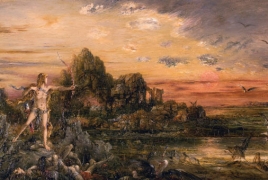
The Frances Lehman Loeb Art Center at Vassar College announces its acquisition of Hercules and the Stymphalian Birds, a painting by renowned 19th century French artist Gustave Moreau, Art Daily report.s
Moreau was trained as an academic history painter but evolved into a very idiosyncratic and personal presenter of standard historical and literary subjects. “His paintings have a very strong spiritual aspect to them and many are technically very highly wrought, the artist often returning to the same painting over the course of years to add to the richly encrusted surfaces,” says James Mundy, the Anne Hendricks Bass director of the Art Center.
Moreau was always interested in the labours of Hercules. In Hercules and the Stymphalian Birds the hero is dressed in a lion’s skin, a bow in his hands, facing wild birds. Moreau shows the sixth of the twelve labours of Hercules, which was to kill the Stymphalian birds. Hercules could not hunt these monstrous carnivorous birds with beaks and feathers of bronze as sharp as a razor. He was saved by Athena who gave him rattlesnakes of bronze made by Hephaestus.
Mundy calls the work, “A small gem of a painting in very good condition. It fills an important gap in our collection, securing the bridge between academic tradition and the Modernism of the era following War War I. It will also serve Vassar’s curriculum by fitting into courses in the art, French, classics, and history departments.”
Professor Brian Lukacher of the Vassar Art Department concurs. “Moreau figures prominently in my teaching of nineteenth-century European art,” he says. “Moreau’s Hercules is classically posed and yet he possesses a lithe, almost frail, physicality. The blighted and yet fantastical landscape of corpses, seen in the red glare of a twilit sky, hints at a fallen world of loss and disaster, not a classical past of ideal emulation. Moreau modernizes the mythic narratives of classical heroism to express the social and psychological anxieties of late 19th-century France.”
Hercules and the Stymphalian Birds is on view now.

